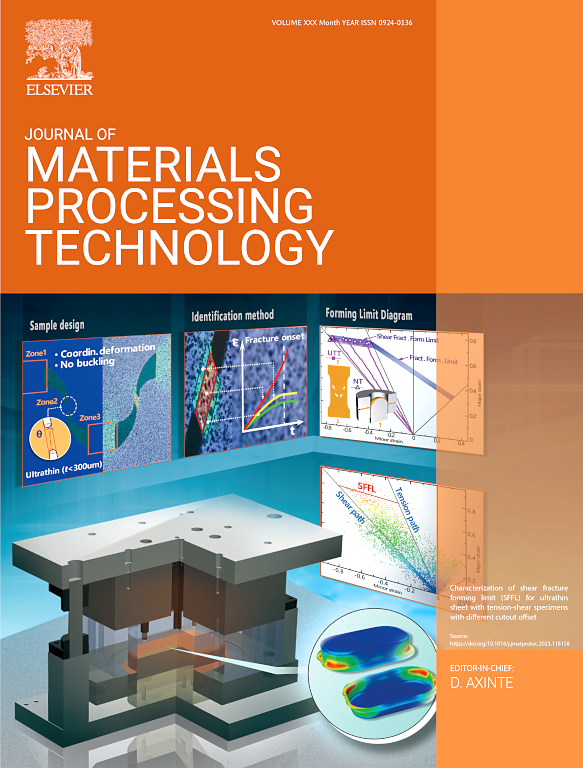An optimization strategy based on critical recrystallization strain to improve the recrystallization rate of ultrasonic impact treatment assisted laser directed energy deposition
IF 6.7
2区 材料科学
Q1 ENGINEERING, INDUSTRIAL
Journal of Materials Processing Technology
Pub Date : 2025-02-13
DOI:10.1016/j.jmatprotec.2025.118774
引用次数: 0
Abstract
In laser directed energy deposition (LDED), the epitaxial growth of long columnar grains often results in performance anisotropy in the component. Severe plastic deformation is a method commonly employed to refine grains. However, current research tends to focus on applying larger pressure loads and strains, which increases the demand for auxiliary equipment and reduces the convenience of application. In this study, we design and optimize a hybrid manufacturing method that combines synchronous ultrasonic impact treatment (UIT) with LDED, leveraging the cumulative characteristics of ultrasonic impact micro-deformation and the principle of critical recrystallization strain. Through mechanical compression and heat treatment experiments, we establish the strain-recrystallization relationship of the material and identified the minimum plastic strain necessary for achieving the maximum recrystallization rate (as the critical recrystallization effective strain). We predicted the plastic strain transfer depth under the current impact parameters using a model and optimized the thickness of the single deposition layer to prevent the recrystallization zone from being covered by the remelted molten pool. Using 316L stainless steel as the verification material, we induced synchronous recovery recrystallization at an exceptionally low output pressure (about 600 N). This optimization led to a significant 56 % refinement in grain size. Compared to the unoptimized experiment, the recrystallization rate increased from 9.14 % to 25.75 %. Furthermore, the yield strength of the material improved by 34 % (compared to a 19 % increase without optimization), all while maintaining high ductility. Additionally, we elucidated the strain and temperature conditions achieved during synchronous recovery recrystallization through a finite element model, and verified the accuracy of this model, allowing for the method's extension to other materials. These findings significantly reduce the demand for high pressure loads on equipment in deformation strengthening methods and enhance practicality.
基于临界再结晶应变的超声冲击处理辅助激光定向能沉积再结晶率优化策略
在激光定向能沉积(LDED)中,长柱状晶粒的外延生长常常导致器件的性能各向异性。剧烈塑性变形是一种常用的细化晶粒的方法。然而,目前的研究倾向于施加更大的压力载荷和应变,这增加了对辅助设备的需求,降低了应用的便利性。在本研究中,我们利用超声冲击微变形的累积特性和临界再结晶应变原理,设计并优化了一种将同步超声冲击处理(UIT)与lcd相结合的混合制造方法。通过机械压缩和热处理实验,建立了材料的应变-再结晶关系,确定了达到最大再结晶速率所需的最小塑性应变(作为临界再结晶有效应变)。利用模型预测了当前冲击参数下的塑性应变传递深度,并优化了单层沉积层的厚度,以防止再结晶区被重熔熔池覆盖。使用316L不锈钢作为验证材料,我们在极低的输出压力(约600 N)下诱导同步恢复再结晶。该优化使晶粒尺寸细化了56% %。与未优化的实验相比,再结晶率由9.14% %提高到25.75% %。此外,材料的屈服强度提高了34% %(与未经优化的19% %相比),同时保持了高延展性。此外,我们通过有限元模型阐明了同步恢复再结晶过程中所达到的应变和温度条件,并验证了该模型的准确性,为该方法的推广提供了条件。这些发现大大减少了变形强化方法对设备高压载荷的需求,提高了实用性。
本文章由计算机程序翻译,如有差异,请以英文原文为准。
求助全文
约1分钟内获得全文
求助全文
来源期刊

Journal of Materials Processing Technology
工程技术-材料科学:综合
CiteScore
12.60
自引率
4.80%
发文量
403
审稿时长
29 days
期刊介绍:
The Journal of Materials Processing Technology covers the processing techniques used in manufacturing components from metals and other materials. The journal aims to publish full research papers of original, significant and rigorous work and so to contribute to increased production efficiency and improved component performance.
Areas of interest to the journal include:
• Casting, forming and machining
• Additive processing and joining technologies
• The evolution of material properties under the specific conditions met in manufacturing processes
• Surface engineering when it relates specifically to a manufacturing process
• Design and behavior of equipment and tools.
 求助内容:
求助内容: 应助结果提醒方式:
应助结果提醒方式:


